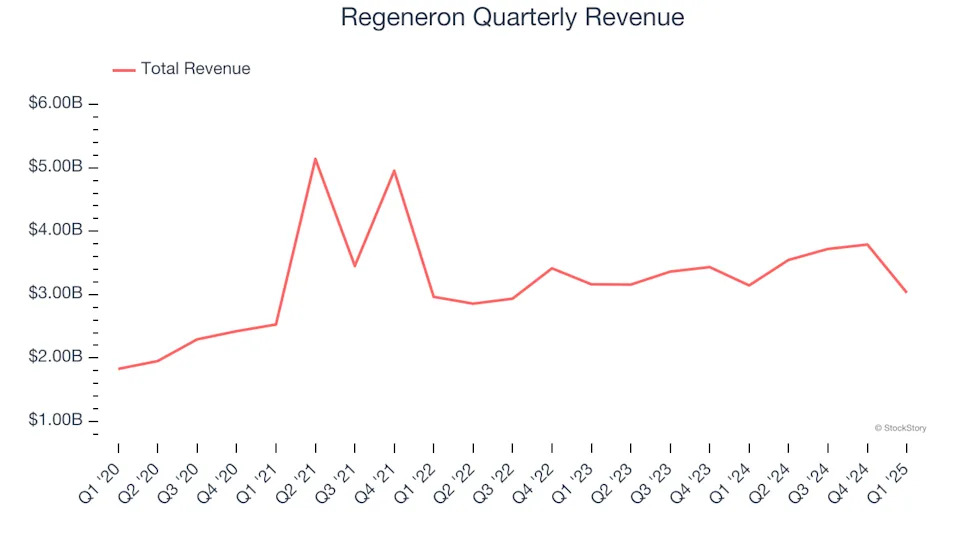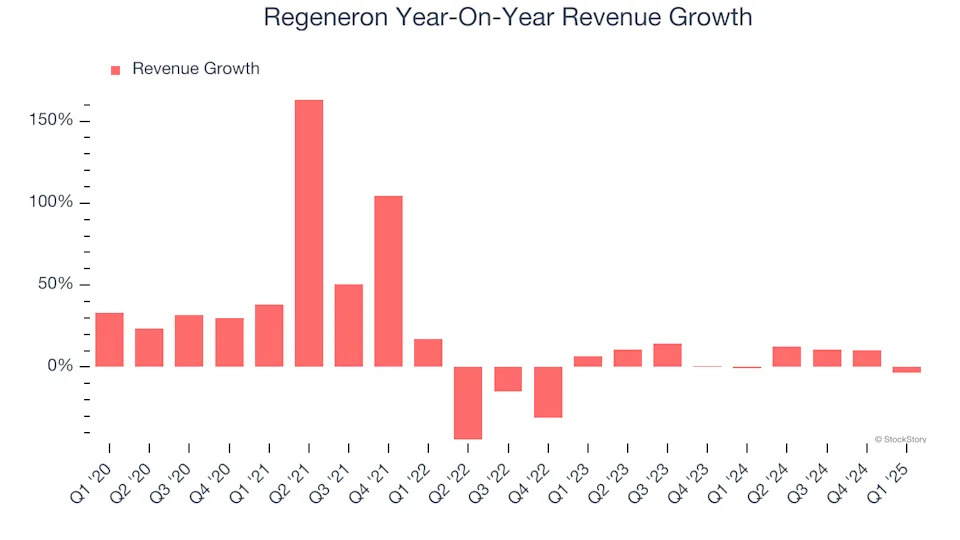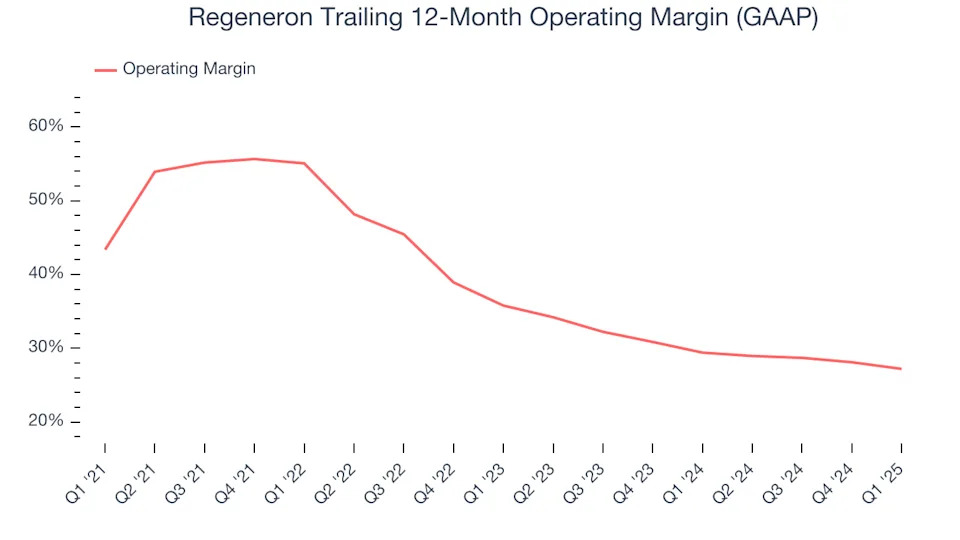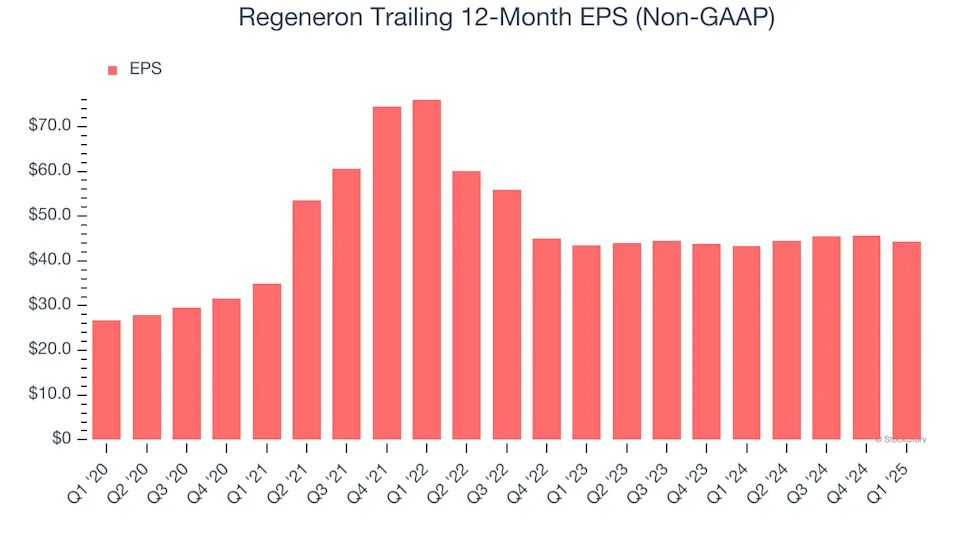Biotech company Regeneron (NASDAQ:REGN) missed Wall Street’s revenue expectations in Q1 CY2025, with sales falling 3.7% year on year to $3.03 billion. Its non-GAAP profit of $8.22 per share was 3% below analysts’ consensus estimates.
Is now the time to buy Regeneron? Find out in our full research report .
Regeneron (REGN) Q1 CY2025 Highlights:
"Regeneron has one of the most exciting pipelines in the industry, with unmatched diversity, scientific distinction, and potential to help millions of patients," said Leonard S. Schleifer, M.D., Ph.D., Board co-Chair, President and Chief Executive Officer of Regeneron.
Company Overview
Founded by scientists who wanted to build a company where science could thrive, Regeneron Pharmaceuticals (NASDAQ:REGN) develops and commercializes medicines for serious diseases, with key products treating eye conditions, allergic diseases, cancer, and other disorders.
Sales Growth
Reviewing a company’s long-term sales performance reveals insights into its quality. Even a bad business can shine for one or two quarters, but a top-tier one grows for years. Thankfully, Regeneron’s 15% annualized revenue growth over the last five years was solid. Its growth beat the average healthcare company and shows its offerings resonate with customers.

Long-term growth is the most important, but within healthcare, a half-decade historical view may miss new innovations or demand cycles. Regeneron’s recent performance shows its demand has slowed as its annualized revenue growth of 6.7% over the last two years was below its five-year trend.

Regeneron also breaks out the revenue for its most important segments, Collaboration and Product & Pipeline, which are 50.6% and 46.7% of revenue. Over the last two years, Regeneron’s Collaboration revenue averaged 13.8% year-on-year growth while its Product & Pipeline revenue averaged 2.6% growth.
This quarter, Regeneron missed Wall Street’s estimates and reported a rather uninspiring 3.7% year-on-year revenue decline, generating $3.03 billion of revenue.
Looking ahead, sell-side analysts expect revenue to remain flat over the next 12 months, a deceleration versus the last two years. This projection doesn't excite us and implies its products and services will see some demand headwinds.
Today’s young investors likely haven’t read the timeless lessons in Gorilla Game: Picking Winners In High Technology because it was written more than 20 years ago when Microsoft and Apple were first establishing their supremacy. But if we apply the same principles, then enterprise software stocks leveraging their own generative AI capabilities may well be the Gorillas of the future. So, in that spirit, we are excited to present our Special Free Report on a profitable, fast-growing enterprise software stock that is already riding the automation wave and looking to catch the generative AI next .
Operating Margin
Regeneron has been a well-oiled machine over the last five years. It demonstrated elite profitability for a healthcare business, boasting an average operating margin of 38.6%.
Analyzing the trend in its profitability, Regeneron’s operating margin decreased by 16.2 percentage points over the last five years. The company’s two-year trajectory also shows it failed to get its profitability back to the peak as its margin fell by 8.6 percentage points. This performance was poor no matter how you look at it - it shows its expenses were rising and it couldn’t pass those costs onto its customers.

This quarter, Regeneron generated an operating profit margin of 19.5%, down 4.4 percentage points year on year. This contraction shows it was less efficient because its expenses increased relative to its revenue.
Earnings Per Share
Revenue trends explain a company’s historical growth, but the long-term change in earnings per share (EPS) points to the profitability of that growth – for example, a company could inflate its sales through excessive spending on advertising and promotions.
Regeneron’s EPS grew at a remarkable 10.6% compounded annual growth rate over the last five years. However, this performance was lower than its 15% annualized revenue growth, telling us the company became less profitable on a per-share basis as it expanded due to non-fundamental factors such as interest expenses and taxes.

We can take a deeper look into Regeneron’s earnings to better understand the drivers of its performance. As we mentioned earlier, Regeneron’s operating margin declined by 16.2 percentage points over the last five years. This was the most relevant factor (aside from the revenue impact) behind its lower earnings; taxes and interest expenses can also affect EPS but don’t tell us as much about a company’s fundamentals.
In Q1, Regeneron reported EPS at $8.22, down from $9.55 in the same quarter last year. This print missed analysts’ estimates, but we care more about long-term EPS growth than short-term movements. Over the next 12 months, Wall Street expects Regeneron’s full-year EPS of $44.31 to shrink by 10.9%.
Key Takeaways from Regeneron’s Q1 Results
We struggled to find many positives in these results. Its revenue missed significantly and its EPS fell short of Wall Street’s estimates. Overall, this quarter could have been better. The stock traded down 1.7% to $600 immediately following the results.
Regeneron may have had a tough quarter, but does that actually create an opportunity to invest right now? The latest quarter does matter, but not nearly as much as longer-term fundamentals and valuation, when deciding if the stock is a buy. We cover that in our actionable full research report which you can read here, it’s free .
